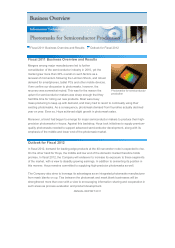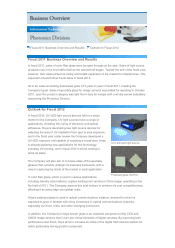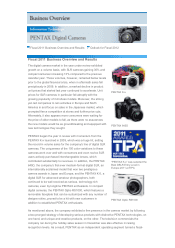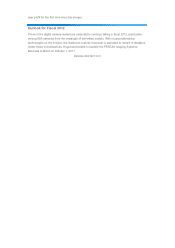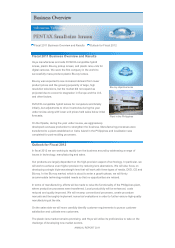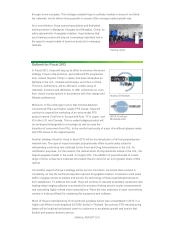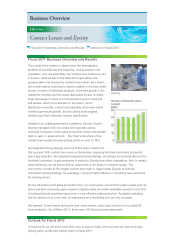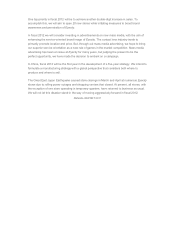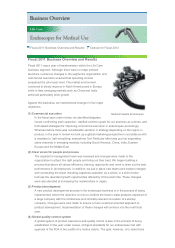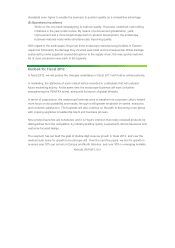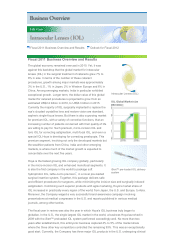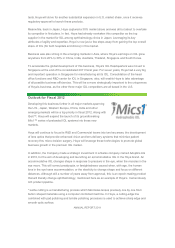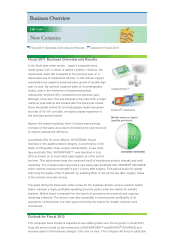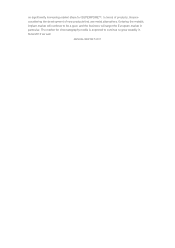Pentax 2011 Annual Report Download - page 41
Download and view the complete annual report
Please find page 41 of the 2011 Pentax annual report below. You can navigate through the pages in the report by either clicking on the pages listed below, or by using the keyword search tool below to find specific information within the annual report.
FFS lenses
Fiscal 2011 Business Overview and Results Outlook for Fiscal 2012
Fiscal 2011 Business Overview and Results
During the fiscal year under review, the retail market for
eyeglass lenses slowly recovered from the economic downturn
that followed the financial crisis. Fiscal 2011 was a year of
pronounced regional differences. Whereas trading in the
developed markets of Western Europe and North America
improved slightly, conditions in Japan, Australia, Spain and the
Nordic countries were much more difficult. Meanwhile, eyeglass
retail markets in the BRIC countries expanded at a rate of
around 20%.
Wholesale markets for eyeglass lenses saw competition intensify because of the entry of low-
priced, single-vision commodity eyeglass lens suppliers from China, India, Eastern Europe and
elsewhere, pushing the wholesale sector closer to competition based on low prices.
Against this backdrop, in local currency terms Hoya delivered sales growth of 10% in Europe,
11% in the U.S. and Canada, and 20% in Asia. In the Japanese market, Hoya performed
strongly, but certain client eyeglass retailers were damaged by the Great East Japan
Earthquake. Consequently, sales in Japan decreased about 2% year on year.
Despite this mixed regional performance, Hoya still outperformed the average market growth
rate in each region for several reasons. The first reason is its sophisticated technology. For
example, in recent years, Free Form Surface (FFS) lenses have started to replace traditional
Progressive Addition Lenses (PALs) in the market for line-free bifocal eyeglasses. By separating
vision correction into horizontal and vertical components on the two surfaces of the lens, Hoya
FFS technology can address an individual’s visual acuity with greater precision and comfort.
Hoya is among the few global suppliers with a robust and growing patent and IP portfolio in this
technology. FFS lenses command a premium price in the market. While conventional PALs still
account for the majority of multi-focal lenses on the global market in volume terms, PALs and
FFS lenses are evenly matched when compared on a monetary basis. In terms of sales volume,
FFS lenses are achieving steady growth worldwide.
Another contributing factor behind Hoya’s strong performance was its brand strategy.
Hoya successfully developed a new base of customers for whom Hoya products were previously
outside of their price range, particularly in the Asian market. This was done by offering lenses
under different brand names with more commoditized features than what is offered in the
Japanese market. Hoya opened new doors by providing commodity lenses to retailers to whom it
previously did not supply products at all. Going forward, the Company intends to go further and
provide these retailers with the in-depth knowledge and experience they would need to carry
Hoya’s top product line. Hoya also established a joint venture with a Chinese company to roll out
a line of lenses priced even lower, under an entirely separate brand and company name.
In essence, Hoya’s strategy is to address the high-end market with the traditional Hoya brand,
while developing the mid-range market with a new brand, and entering the low-end market


